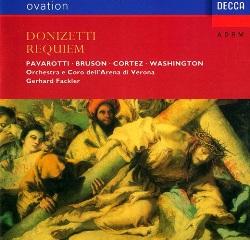Gaetano Donizetti – Requiem (1979)
Gaetano Donizetti – Requiem (1979)

1. Requiem: Requiem Aeternam - Kyrie - Requiem Aeternam 2. Requiem: In Memoria Aeterna 3. Requiem: Dies Irae play 4. Requiem: Tuba Mirum 5. Requiem: Judex Ergo 6. Requiem: Rex Tremendae Majestatis 7. Requiem: Ingemisco 8. Requiem: Preces Maledictis 9. Requiem: Confutatis Maledictis 10. Requiem: Oro Supplex 11. Requiem: Lacrymosa Dies Illa 12. Requiem: Domine, Jesu Christe 13. Requiem: Lux Aeterna play 14. Requiem: Libera Me Domine Renato Bruson Luciano Pavarotti Viorica Cortez Paolo Washington Verona Teatro Arena Orchestra Verona Teatro Arena Chorus Gerhard Fackler - conductor, 1979
Originally begun as a work in memory of Bellini, this mass was never finished, only published as it existed in 1870 and, ironically, its first performance occurred on the occasion of the removal of Donizetti's remains to a grander site. Lacking a "Sanctus", "Benedictus" and "Agnus Dei", the work is nevertheless a large-scale (lasting more than an hour), powerful and compelling work which is one of Donizetti's most important non-operatic compositions. --- recordsinternational.com
Unfinished requiem for 3 soloists in D minor, chorus & orchestra (for his friend and composer Bellini; unfinished) contains: "Judex ergo", "Domine Jesu Christe" and "Ingemisco". The requiem is dedicated to Donizetti's friend Vincenzo Bellini (1801 - 1835). In this requiem, Donizetti brings into play the tradition of Italian church music and a new style, thoroughly inspired by music drama, like that which was to stamp Verdi's requiem forty years later. The work is broadly laid out, and its alternation of solo and choral parts is entirely operatic in nature. However, Donizetti could not disavow his training as a church musician, which emerges in the heavily word-oriented interpretation of the liturgical text and in repeated reminiscences of the rigorous compositional style. Although the work lacks the dramatic tension and power characteristic of Verdi's requiem, it nevertheless contains a number of strikingly concise effects, especially in the alternation of the typically Donizettian cantilenas and of the powerfully surging, dramatic choral sections. Particularly impressive is the "Dies Irae" with its vividly contrasting sections, which are nonetheless formally integrated into a larger context. --- Gottfried Kraus
download: uploaded anonfiles yandex 4shared solidfiles mediafire mega filecloudio
Last Updated (Wednesday, 30 October 2013 10:24)








